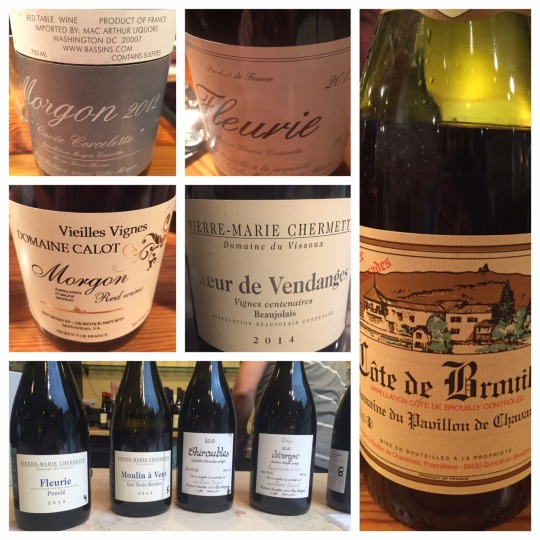
It’s November, the time of the year when the commercial wine industry turns to Beaujolais Nouveau – the just-released candied-cherry-smacking wine from a region in France that has long been seen as the ugly duckling to Burgundy.
But in recent decades, winemakers in the 10 Cru-designated villages have been fighting to show off what their Gamay and terroir can do. High-profile big-city somms and the “cool kids” of the wine scene, have been flocking to the Crus for a while now: Morgon and Fleurie are the first villages I was exposed to among my wine-drinking friends. It’s history in the natural wine movement (read Alice Feiring’s Naked Wine) and its growing stature are signs this isn’t just a trend. And then last month, Decanter reported this:
The 10 crus of Beaujolais have instructed a series of working groups to identity and list individual climats by June next year, as they seek to emulate Burgundy by linking vineyards more closely to terroir.
So in my quest to understand the wine world, and to keep up with my more knowledgeable friends, I set out to learn more about the 10 Crus and put together an extremely informal, very unscientific tasting. I asked my friends at Weygandt Wines to suggest three Crus I could taste side-by-side. My hope was that I would get an understanding for these wines and maybe even be able to pull out some trademarks that I could remember for future purchases (i.e. Fleuries are more floral, Brouilly are lighter). There’s already some buzz around the 2014 vintage, which are just starting to come in, so Tim and Warren recommended these:
- Clos de la Roilette (Coudert) Fleurie (2014)
- Daniel Bouland Cote de Brouilly (2014)
- Pierre-Marie Chermette Coeur de Vendanges (2014
– while not one of the Crus, this wine comes from 100-year-old vines and
was highly recommended as a good alternative.)
Also, some friends were kind to join me in this learning experiment, so a few more were popped and poured:
- Domaine du Pavillon de Chavannes de Chavannes Côte de
Brouilly (2014) - Jean Foillard Morgon Cuvée Corcelette (2012)
- Domaine Calot Vielles Vignes Morgon (2014)
- Yvon Métras Fleurie (2013)
And I should add that just prior to my informal tasting, Weygandt’s had also set up a tasting of mostly 2013s, so I stopped by for some pre-experiment sips:
- Pierre-Marie Chermette Brouilly, Fleurie and
Moulin à Vent (2013) - Daniel Bouland Chiroubles and Morgon (2013)
- Chateau Grange Cochard Morgon (2012 and 2013)
- Domaine de Prion La Madone Fleurie andMoulin à Vent (2011)
Phew – all that spanned a single afternoon.
My Saturday conclusions:
I must admit that I don’t know more than I did before we started. Sure, I enjoyed some over others. For example, the nose on the Chateaeu Grange Cochard Morgon 2013 had gorgeous herbal aromas that the 2012 lacked (yet the palate on the 2012 was more rounded). And certain wines tasted like they were trying to emulate Burgundy. But producer styles seemed to win out over terroir. When comparing crus within a single producer, that’s when I was able to slightly pick out differences. Of the three initial wines – it was the non-Cru designated Pierre-Marie Chermette Coeur de Vendanges that I enjoyed most. I went home later that night slightly unsatisfied with no overarching themes for individual Crus.
Fortunately, my frustration dissipated when I read “What’s the Big Deal About Cru Beaujolais,” on wine-searcher, which includes these “caveats” to understanding this wine:
Two issues: first is that the crus are not entirely sure of their identity or about their relationship with Burgundy. Second, they are made by several different techniques, including carbonic maceration (the traditional way), thermovinification (a quick fix, where the
grapes and must are heated to near boiling prior to fermentation) or
traditional Burgundian winemaking methods – this can cause confusion as each gives a very different wine style.
And I had another takeaway:
I wasn’t as in love with these wines as I wanted to be. Nothing blew me away. They were all bottles that generally do fit my palate and were enjoyable. But it’s a wine I would pull for an occasion: a pairing with a roast chicken dinner or a table of friends who just want something light. I must say, Cru Beaujolais really does lend itself to Autumn. It’s a beautiful transition wine from the hot summer days to impending doom – oops, I mean cooler weather.
But then something interesting happened. We had a lot of leftover wine and I brought home the three original bottles that I brought –and snagged the rest of the Métras Fleurie. About two days later – after some time in my refrigerator and then warmed back up to about 10 degrees below room temperature, some of the dirtier/earthier flavors started to emerge. The wines tasted fuller, and more rounded. Day three only enhanced that.
So my final assessment:
Cru Beaujolais, which is meant to age (quite the opposite of Beaujolais Nouveau, which most of the wine-drinking public associates with the region), really does benefit from either time in the bottle or a healthy decant or lingering in a refrigerator for a few days after opening. Any future real comparative tastings would probably benefit from one of those methods. As for which Cru I prefer or can properly describe, I still don’t know. And I’m ok with that. Making my way through 10 different terroirs and more than a handful of recommended producers will take a bit of time and is certainly not a bad way to continue on my wine journey.
Cheers!